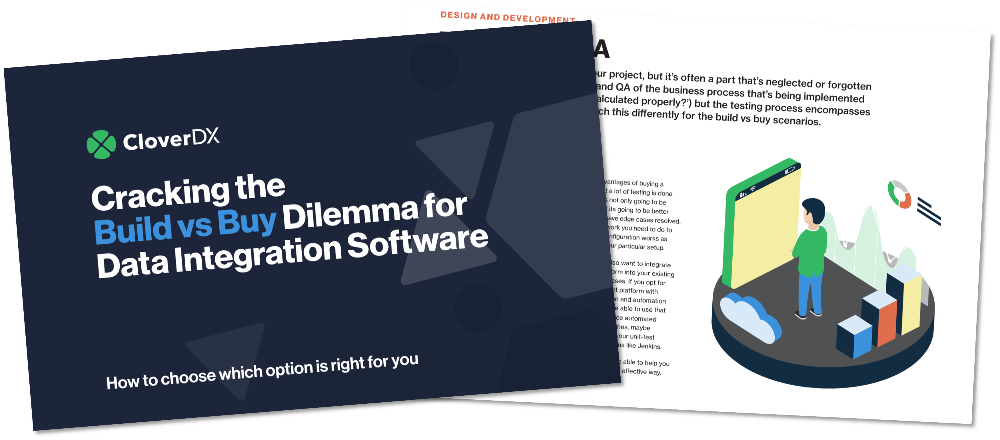What's in this webinar?
Chapter 1: Data migration from legacy systems (0:25)
A look at what a migration is and how it relates to replacing legacy systems, and what's involved when you're trying to replace an outgoing system with something that's potentially from a different era.
/2021-12-14_02%20Legacy%20systems%20part%20of%20your%20tech%20stack%20(848%208730%201563).jpg?width=500&height=281&name=2021-12-14_02%20Legacy%20systems%20part%20of%20your%20tech%20stack%20(848%208730%201563).jpg)
Chapter 2: Integrating legacy systems (4:20)
How legacy systems can be integrated into a modern tech stack, either temporarily or permanently.
/2021-12-14_03%20Legacy%20systems%20part%20of%20your%20tech%20stack%20(848%208730%201563).jpg?width=500&height=281&name=2021-12-14_03%20Legacy%20systems%20part%20of%20your%20tech%20stack%20(848%208730%201563).jpg)
Chapter 3: Approach #1 - File extracts (4:40)
The simplest form of integration through manual reports and exports. More often than not, the most challenging part in this approach is data formats, quite often aimed at human consumption rather than integration.
/2021-12-14_04%20Legacy%20systems%20part%20of%20your%20tech%20stack%20(848%208730%201563).jpg?width=500&height=281&name=2021-12-14_04%20Legacy%20systems%20part%20of%20your%20tech%20stack%20(848%208730%201563).jpg)
Chapter 4: Approach #2 - Direct access to backend database (6:30)
Although not recommended practice, this can bring quick wins and results, especially when you need to get data out of the legacy system and not write.
/2021-12-14_05%20Legacy%20systems%20part%20of%20your%20tech%20stack%20(848%208730%201563).jpg?width=500&height=281&name=2021-12-14_05%20Legacy%20systems%20part%20of%20your%20tech%20stack%20(848%208730%201563).jpg)
Chapter 5: Approach #3 - Using an ETL tool (8:50)
How bringing in a data integration/ETL tool to the mix can open up your options and improve the usefulness of the data as well as cover more business processes.
/2021-12-14_06%20Legacy%20systems%20part%20of%20your%20tech%20stack%20(848%208730%201563).jpg?width=500&height=281&name=2021-12-14_06%20Legacy%20systems%20part%20of%20your%20tech%20stack%20(848%208730%201563).jpg)
Chapter 6: Data quality and mapping (11:00)
Data quality and data mapping are the two biggest issues when integrating or migrating legacy systems. Knowledge gaps in both the old and new systems can make this tricky, but CloverDX can make mapping easier to build and verify.
/2021-12-14_07%20Legacy%20systems%20part%20of%20your%20tech%20stack%20(848%208730%201563).jpg?width=500&height=281&name=2021-12-14_07%20Legacy%20systems%20part%20of%20your%20tech%20stack%20(848%208730%201563).jpg)
Chapter 7: Execution (17:40)
Once you know your approach, here are some thoughts about taking it to production.
/2021-12-14_08%20Legacy%20systems%20part%20of%20your%20tech%20stack%20(848%208730%201563).jpg?width=500&height=281&name=2021-12-14_08%20Legacy%20systems%20part%20of%20your%20tech%20stack%20(848%208730%201563).jpg)
Chapter 8: Introduction to CloverDX (18:43)
The CloverDX Data Management Platform allows you to take Approach #3, giving you lots of options for accessing data in legacy applications. CloverDX also enables you to connect to their modern counterparts, as well as design complex business processes and data pipelines.
/2021-12-14_09%20Legacy%20systems%20part%20of%20your%20tech%20stack%20(848%208730%201563).jpg?width=500&height=281&name=2021-12-14_09%20Legacy%20systems%20part%20of%20your%20tech%20stack%20(848%208730%201563).jpg)

Build vs buy: Cracking the dilemma
Should you continue investing into your homegrown DIY data integration solution? Or should you bite the bullet and invest in a commercial data platform?
If your ETL processes aren't as reliable, transparent or easy to maintain as you'd like, it might be time to start looking for a more robust solution.
This guide will walk you through every aspect of the decision so you can make an informed choice.


